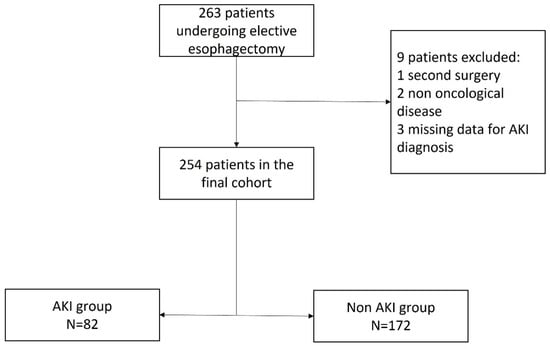Journal Description
Kidney and Dialysis
Kidney and Dialysis
is an international, peer-reviewed, open access journal on nephrology and dialysis published quarterly online by MDPI.
- Open Access— free for readers, with article processing charges (APC) paid by authors or their institutions.
- Rapid Publication: manuscripts are peer-reviewed and a first decision is provided to authors approximately 19.1 days after submission; acceptance to publication is undertaken in 7.9 days (median values for papers published in this journal in the second half of 2023).
- Recognition of Reviewers: APC discount vouchers, optional signed peer review, and reviewer names published annually in the journal.
Latest Articles
Incidence, Risk Factors, and Consequences of Acute Kidney Injury in Patients Undergoing Esophageal Cancer Surgery: A Historical Cohort
Kidney Dial. 2024, 4(2), 93-104; https://doi.org/10.3390/kidneydial4020007 - 03 Apr 2024
Abstract
Background: Limited data exist on postoperative acute kidney injury (AKI) in patients who have undergone esophageal cancer surgery. The purpose of this study was to evaluate the incidence, risk factors, and consequences of postoperative acute kidney after esophagectomy. Methods: This was a retrospective
[...] Read more.
Background: Limited data exist on postoperative acute kidney injury (AKI) in patients who have undergone esophageal cancer surgery. The purpose of this study was to evaluate the incidence, risk factors, and consequences of postoperative acute kidney after esophagectomy. Methods: This was a retrospective cohort study. The study was conducted in a tertiary specialized cancer center in Italy. All patients undergoing elective esophageal cancer surgery between 2016 and 2021 were included in the study. AKI was defined according to Kidney Disease Improving Global Outcomes criteria (both serum creatinine and urine output), within 48 h after surgery. Preoperative and intraoperative data were registered. We also collected data concerning progression of AKI, need for renal replacement therapy, mortality, and medical (pulmonary, cardiovascular, septic) and surgical complications within 30 days from surgery, as well as length of hospital stay. Results: Incidence of postoperative AKI was 32%. The independent risk factors were body mass index and the use of an invasive surgical approach. Persistent AKI accounted for 15% of the cases and it was associated with increased risk of major cardiovascular events (odds ratio 4.14, 95% CI 1.05–15.8, p-value 0.036), pulmonary complications (OR 3.67, 95% CI 1.04–14.9, p-value 0.050), and increased length of hospital stay (AME 7.2, 0.5–13.9, p-value 0.035). Conclusions: Postoperative AKI is common after esophageal cancer surgery. BMI and a totally invasive surgical approach are independent risk factors. Persistent AKI lasting more than 48 h increased the risk for any cardiovascular or pulmonary complications, with prolonged length of hospital stay.
Full article
(This article belongs to the Special Issue Feature Papers for Kidney and Dialysis: Advances in Nephrology and Dialysis—Series II)
►
Show Figures
Open AccessReview
Acute Kidney Injury Associated with Severe Leptospirosis: Fatal Re-Emerging Disease in Latin America
by
Elber Osorio-Rodríguez, Dairo Rodelo-Barrios, Carlos Rebolledo-Maldonado, Alberto Polo-Barranco, Jhonny Patiño-Patiño, Mauricio Aldana-Roa, Valeria Sánchez-Daza, Emily Sierra-Ordoñez and Alfonso Bettin-Martínez
Kidney Dial. 2024, 4(2), 78-92; https://doi.org/10.3390/kidneydial4020006 - 03 Apr 2024
Abstract
►▼
Show Figures
Leptospirosis is a re-emerging zoonotic disease that has had an unprecedented impact on most health systems in the world. The spectrum of symptoms is variable and usually ranges from asymptomatic cases to severe manifestations involving multiple organ dysfunction accompanied by jaundice, hemorrhage, meningitis,
[...] Read more.
Leptospirosis is a re-emerging zoonotic disease that has had an unprecedented impact on most health systems in the world. The spectrum of symptoms is variable and usually ranges from asymptomatic cases to severe manifestations involving multiple organ dysfunction accompanied by jaundice, hemorrhage, meningitis, and acute kidney injury that requires the need for intensive care assistance. Although early antibiotic treatment is usually effective, in severe cases, it may require renal replacement therapy, invasive mechanical ventilation, vasoactive support, and invasive hemodynamic monitoring, increasing the risk of death. In Latin America, the real burden of acute kidney injury in this condition is unknown and may be underestimated due to the rapid progression of the disease, similar to other vector zoonoses, and the low coverage of diagnostic tests in primary care, especially in rural regions. Therefore, below, we review the clinical aspects and describe the scientific, clinical, and therapeutic evidence of acute kidney injury attributed to Leptospira spp. and its relevance in patients with severe leptospirosis in Latin America.
Full article
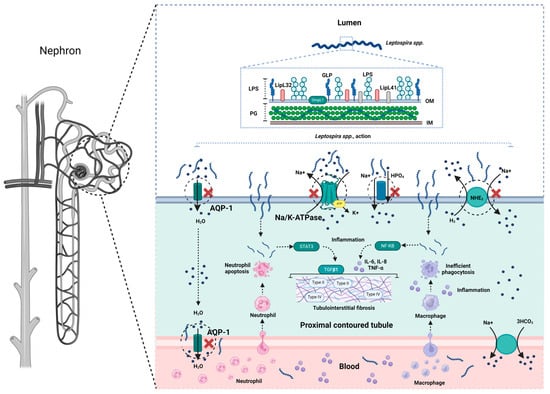
Figure 1
Open AccessReview
Nutritional Recommendations for Pregnant Women Receiving Dialysis: A Scoping Review
by
Elyce Cutajar and Kelly Lambert
Kidney Dial. 2024, 4(1), 46-77; https://doi.org/10.3390/kidneydial4010005 - 15 Mar 2024
Abstract
Pregnancy in the dialysing population is an infrequent but increasing event. There is a lack of contemporary guidance regarding the nutritional management of this complex patient group. The aim of this scoping review was to identify, evaluate and summarise the evidence base describing
[...] Read more.
Pregnancy in the dialysing population is an infrequent but increasing event. There is a lack of contemporary guidance regarding the nutritional management of this complex patient group. The aim of this scoping review was to identify, evaluate and summarise the evidence base describing nutritional recommendations for pregnant women receiving dialysis. A systematic search strategy of four databases and the grey literature was conducted. Eligible publications contained reference to recommendations regarding nutrition, supplements, breastfeeding, dietary patterns, and/or weight recommendations for pregnant dialysing women. A total of 136 eligible records were included for synthesis including 66 case reports/case series, 46 reviews, 15 book chapters, 5 editorials, and 4 consensus guidelines/position papers. Recommendations regarding energy, protein, dietary patterns, weight, and vitamin and mineral supplementation were common. However, significant discrepancy across these recommendations was evident. There were limited recommendations regarding other nutrients and breastfeeding. A summary of nutritional recommendations to guide clinical practice was constructed. Pregnancy planning, pre-conception dietetic counselling, interprofessional education, and the guidance synthesised in this review could be utilised by clinicians to improve clinical management and optimise outcomes in these patients. Future research should explore the experiences and perspectives of pregnant dialysing women, investigate nutrient losses during intensive dialysis, and evaluate postpartum follow-up.
Full article
(This article belongs to the Special Issue Obstetric Nephrology—Emerging Field Both in Obstetrics and Nephrology)
►▼
Show Figures
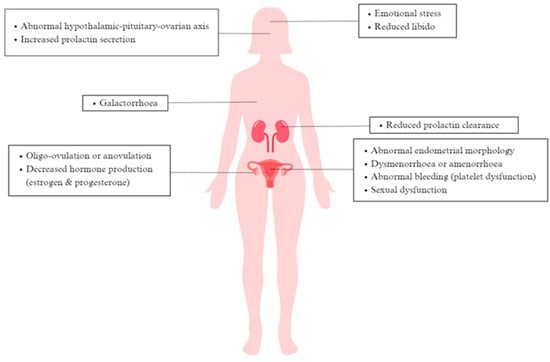
Figure 1
Open AccessReview
Etiology, Clinical Approach, and Therapeutic Consequences of Hyponatremia
by
Goce Spasovski
Kidney Dial. 2024, 4(1), 37-45; https://doi.org/10.3390/kidneydial4010004 - 17 Feb 2024
Abstract
►▼
Show Figures
A perturbation in the water balance rather than any change in salt content is the main cause of hyponatremia, the most frequent electrolyte abnormality, defined as a serum sodium concentration <135 mEq/L. Hyponatremia may be divided between mild (Na > 120 mEq/L) or
[...] Read more.
A perturbation in the water balance rather than any change in salt content is the main cause of hyponatremia, the most frequent electrolyte abnormality, defined as a serum sodium concentration <135 mEq/L. Hyponatremia may be divided between mild (Na > 120 mEq/L) or severe (Na < 120 mEq/L) hyponatremia, and is most frequently observed in elderly ICU hospitalized patients. Based on tonicity, hyponatremia may be hypotonic (a decreased concentration of the solute), isotonic, and hypertonic (falsely low sodium). According to the volume of extracellular fluid (ECF), hyponatremia is further divided among hypovolemic, euvolemic, or hypervolemic hyponatremia. Finally, hyponatremia may develop rapidly as acute (<48 h), usually with severe symptoms, or slowly as chronic hyponatremia, usually being asymptomatic or with mild symptoms. Acute severe hyponatremia presents with severe CNS problems, increased hospitalization rates, and mortality. The treatment with 3% sodium chloride and a 100 mL IV bolus based on severity and persistence of symptoms needs careful monitoring. A non-severe hyponatremia may be treated with oral urea. In asymptomatic mild hyponatremia, an adequate solute intake with an initial fluid restriction of 500 mL/d adjusted according to the serum sodium levels is preferred. Vaptans could be considered in patients with high ADH activity regardless of whether they are euvolemic or hypervolemic. In general, the treatment of hyponatremia should be based on the underlying cause, the duration and degree of hyponatremia, the observed symptoms, and volume status of patient.
Full article
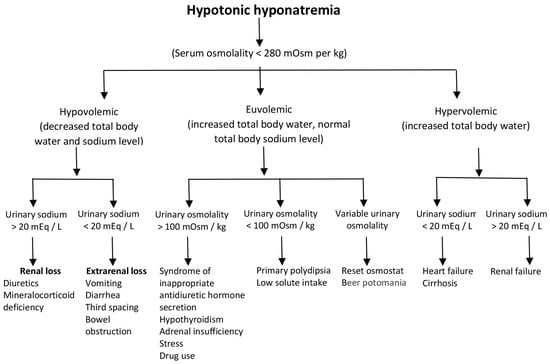
Figure 1
Open AccessReview
One-Size-Does-Not-Fit-All: The Case of Incremental Hemodialysis
by
Francesco Gaetano Casino and Carlo Basile
Kidney Dial. 2024, 4(1), 27-36; https://doi.org/10.3390/kidneydial4010003 - 10 Jan 2024
Abstract
Conventional hemodialysis (HD) (a 4 h session three times a week) is not appropriate for everyone and is excessive in the presence of substantial residual kidney function (RKF). However, it can be safely replaced by a softer incremental approach guided by the urea
[...] Read more.
Conventional hemodialysis (HD) (a 4 h session three times a week) is not appropriate for everyone and is excessive in the presence of substantial residual kidney function (RKF). However, it can be safely replaced by a softer incremental approach guided by the urea kinetic model (UKM), starting with one or two sessions a week. Observational data suggest that RKF may be lost less quickly if dialysis is initiated less frequently than 3 times a week. Incremental HD means that, in the presence of substantial RKF, kidney replacement therapy can begin with low doses and/or frequencies, which, however, must be adequately increased to compensate for any subsequent losses of RKF, keeping the total clearance level (kidney + dialysis) always above the minimum levels of adequacy. In HD, there are complexities in combining the dialysis dose with RKF, but tools have been developed to facilitate this issue. The literature findings lend support to the safety of incremental HD and highlight the potential for this method to be implemented as a new standard of care in dialysis patients with substantial RKF. Ongoing and future trials will likely generate further evidence of the clinical and healthcare benefits of incremental HD in routine practice.
Full article
(This article belongs to the Special Issue Feature Papers for Kidney and Dialysis: Advances in Nephrology and Dialysis—Series II)
Open AccessReview
Urgent-Start Peritoneal Dialysis: Current State and Future Directions
by
Braden Vogt and Ankur D. Shah
Kidney Dial. 2024, 4(1), 15-26; https://doi.org/10.3390/kidneydial4010002 - 04 Jan 2024
Cited by 1
Abstract
Urgent-start peritoneal dialysis (USPD) is defined as peritoneal dialysis initiated within 14 days of catheter insertion. In this review, the authors describe the most recent data on USPD, including outcomes, complications, barriers to implementation, and areas for future research. Outcomes appear similar between
[...] Read more.
Urgent-start peritoneal dialysis (USPD) is defined as peritoneal dialysis initiated within 14 days of catheter insertion. In this review, the authors describe the most recent data on USPD, including outcomes, complications, barriers to implementation, and areas for future research. Outcomes appear similar between catheter insertion techniques, so patient factors and institutional workflow should guide practice. Mechanical complications may occur at a higher rate in USPD, but it does not impact technique survival or mortality. Infectious complications appear unchanged in USPD, and there may be fewer complications compared to urgent-start hemodialysis. Barriers to implementation are multifactorial, including physician and staff unfamiliarity and lack of institutional support. A significant limitation within the field includes lack of uniform terminology and definitions.
Full article
(This article belongs to the Special Issue Feature Papers for Kidney and Dialysis: Advances in Nephrology and Dialysis—Series II)
►▼
Show Figures
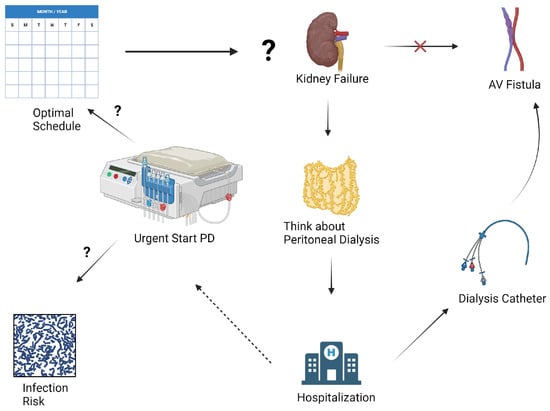
Figure 1
Open AccessReview
An Update on Hypomagnesemia and Hypermagnesemia
by
Steven Van Laecke
Kidney Dial. 2024, 4(1), 1-14; https://doi.org/10.3390/kidneydial4010001 - 24 Dec 2023
Abstract
►▼
Show Figures
Magnesium is an essential element with a pleiotropic role in human biology. Despite tight intestinal and renal regulation of its balance, insufficient intake can finally result in hypomagnesemia, which is a proxy of intracellular deficiency. Conditions such as diabetes, cancer, and infections are
[...] Read more.
Magnesium is an essential element with a pleiotropic role in human biology. Despite tight intestinal and renal regulation of its balance, insufficient intake can finally result in hypomagnesemia, which is a proxy of intracellular deficiency. Conditions such as diabetes, cancer, and infections are often associated with hypomagnesemia, which mostly predicts an unfavorable outcome. The effects of hypomagnesemia can either be direct and include neurological and cardiovascular symptoms or indirect, taking a mechanistic role in inflammation, endothelial dysfunction, and oxidative stress. The indication for intravenous magnesium as a treatment of torsades de pointes and pre-eclampsia is unrefuted, but new indications of peroral or intravenous supplementation, albeit with less supporting evidence, have emerged suggesting, respectively, an attenuation of vascular calcification in chronic kidney disease and improved rate control in atrial fibrillation. Other potential beneficial properties of magnesium, which were claimed by observational data, such as lipid lowering and renal protection, were not, or only partially, investigated in randomized controlled trials. Thus, the role of peroral supplementation of mild chronic asymptomatic hypomagnesemia should be separated from the more targeted prescription of magnesium in specific study populations. (Severe) hypermagnesemia is potentially life-threatening and occurs almost uniformly in subjects with severe renal failure exposed to either supplements or to magnesium-containing cathartics or antacids. Moderate hypermagnesemia is very common in pre-eclamptic women treated with intravenous magnesium. For most (but not all) studied endpoints, mild hypermagnesemia yields a survival benefit. Long-lasting concerns about the potential negative effects of mild hypermagnesemia on bone physiology and structure have so far not been unequivocally demonstrated to be troublesome.
Full article
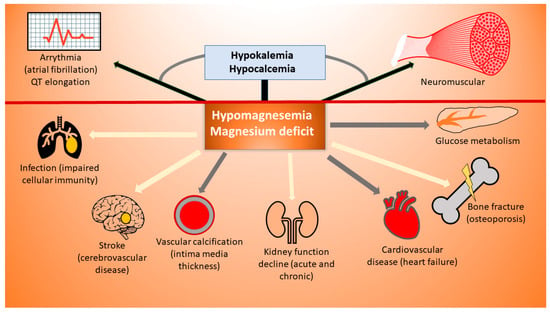
Figure 1
Open AccessReview
The View of Pediatric Nephrotic Syndrome as a Podocytopathy
by
Pedro Alves Soares Vaz de Castro, Thomas Fujihara Ide, Fernando Crespo Torres and Ana Cristina Simões e Silva
Kidney Dial. 2023, 3(4), 346-372; https://doi.org/10.3390/kidneydial3040030 - 12 Dec 2023
Abstract
►▼
Show Figures
Nephrotic syndrome (NS) is a complex clinical entity characterized by proteinuria, hypoalbuminemia, and edema. In this review, we propose the view of NS as a podocytopathy, highlighting the importance of understanding the role of podocytes in the development of this condition. We discuss
[...] Read more.
Nephrotic syndrome (NS) is a complex clinical entity characterized by proteinuria, hypoalbuminemia, and edema. In this review, we propose the view of NS as a podocytopathy, highlighting the importance of understanding the role of podocytes in the development of this condition. We discuss the various etiologies of NS, ranging from congenital to primary renal diseases, as well as secondary forms due to systemic diseases. We also delve into the mechanisms underlying podocyte injury, which plays a crucial role in the development of NS. By viewing NS as a podocytopathy, we suggest potential implications for the diagnosis and treatment of this condition, including the use of podocyte-specific biomarkers and targeted therapies. Our review provides a comprehensive overview of NS and its underlying mechanisms, emphasizing the importance of a multidisciplinary approach to the diagnosis and management of this condition. Further research is essential to better understand the complex interplay between podocyte injury and the development of NS, with the ultimate goal of improving patient outcomes.
Full article
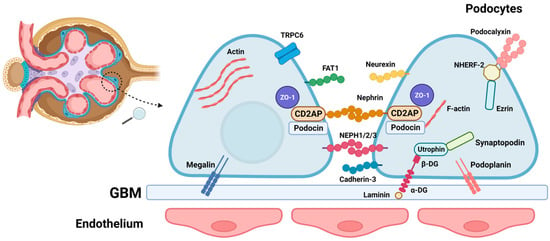
Figure 1
Open AccessBrief Report
Clinical Phenotype and Outcomes of Indo-Asian Patients with ANCA-Associated Glomerulonephritis in the North West, UK
by
Lauren Floyd, Joshua Storrar, Sanjeev Pramanik, Adam D. Morris, Smeeta Sinha, Silke R. Brix, Philip A. Kalra and Ajay P. Dhaygude
Kidney Dial. 2023, 3(4), 335-345; https://doi.org/10.3390/kidneydial3040029 - 06 Nov 2023
Abstract
►▼
Show Figures
ANCA-associated vasculitides (AAV) are rare, autoimmune conditions associated with end-stage kidney disease (ESKD) and mortality. Data have predominately been from White populations of European ancestry although geographical differences are well documented. Few studies have looked at the incidence, phenotype and clinical outcomes of
[...] Read more.
ANCA-associated vasculitides (AAV) are rare, autoimmune conditions associated with end-stage kidney disease (ESKD) and mortality. Data have predominately been from White populations of European ancestry although geographical differences are well documented. Few studies have looked at the incidence, phenotype and clinical outcomes of ethnic minority patients, in particular Indo-Asian populations. A two-center, retrospective cohort study was conducted of patients with ANCA-associated glomerulonephritis (AAGN), self-identifying as Indo-Asian in the North West, UK between 2009 and 2023. A control group of White patients was identified from the same databases and recruited consecutively in relation to the original cohort of Indo-Asian patients. A total of 66 patients were included, 24 patients of Indo-Asian ethnicity and a control cohort of 42 patients of White ethnicity. Indo-Asian patients had a lower median age at diagnosis (53.0 vs. 57.5 years, p = 0.15) and there was an increased prevalence of diabetes mellitus (33.3% vs. 4.8%, p = 0.002) and a higher incidence of previous TB exposure (12.5% vs. 0%, p = 0.019). Outcomes including relapse, ESKD and mortality were similar. We demonstrated an increased crude incidence of AAGN in Indo-Asian patients in the UK compared to similar epidemiological studies. Consideration needs to be given to epidemiological and genetic research, achieved by collaboration and broader recruitment in clinical trials.
Full article
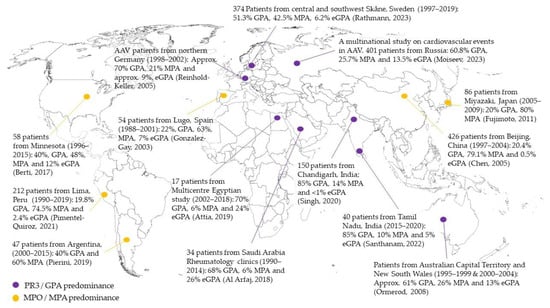
Figure 1
Open AccessArticle
Myocardial Remodeling in Early Chronic Kidney Disease—Mineral and Bone Disorder Model with Low Bone Turnover
by
Evdokia Bogdanova, Airat Sadykov, Galina Ivanova, Irina Zubina, Olga Beresneva, Olga Galkina, Marina Parastaeva, Vladimir Sharoyko and Vladimir Dobronravov
Kidney Dial. 2023, 3(4), 322-334; https://doi.org/10.3390/kidneydial3040028 - 03 Oct 2023
Abstract
►▼
Show Figures
Chronic kidney disease—mineral and bone disorder (CKD-MBD) plays a significant role in causing cardiovascular morbidity and mortality related to CKD. CKD-MBD has been studied during advanced stages when changes in inorganic phosphate (Pi) and its hormonal regulation are obvious. The initial phases of
[...] Read more.
Chronic kidney disease—mineral and bone disorder (CKD-MBD) plays a significant role in causing cardiovascular morbidity and mortality related to CKD. CKD-MBD has been studied during advanced stages when changes in inorganic phosphate (Pi) and its hormonal regulation are obvious. The initial phases of myocardial remodeling (MR) in early CKD-MBD remain poorly understood. We induced mild CKD-MBD in spontaneously hypertensive rats using 3/4 nephrectomy. Animals were fed standard chow, containing 0.6% phosphate. In each animal, we analyzed indices of chronic kidney injury, bone turnover and Pi exchange, and assessed the myocardial histology and gene expression profile. Applied CKD-MBD models corresponded to human CKD S1-2 with low bone turnover and without an increase in systemic Pi-regulating factors (parathyroid hormone and fibroblast growth factor 23). In mild CKD-MBD models, we found MR features characterized by cardiomyocyte hypertrophy, interstitial and perivascular fibrosis, intramyocardial artery media thickening, along with alterations in Ppp3ca, Mapk1, Jag1, Hes1, Ptch1, Numb, Lgr4 and Bmp4 genes. Among other genes, the down-regulation of Jag1 was most tightly associated with either myocardial hypertrophy or fibrosis. Myocardial alterations concurrently occurred with mild CKD-MBD and comprised fibrosis preceding cardiomyocyte hypertrophy. The histological features of MR were associated with myocardial P accumulation in settings of low bone turnover, prior to a response of systemic Pi-regulating factors and with alterations in calcineurin, ERK1/2, Notch, BMP and Hedgehog genes.
Full article
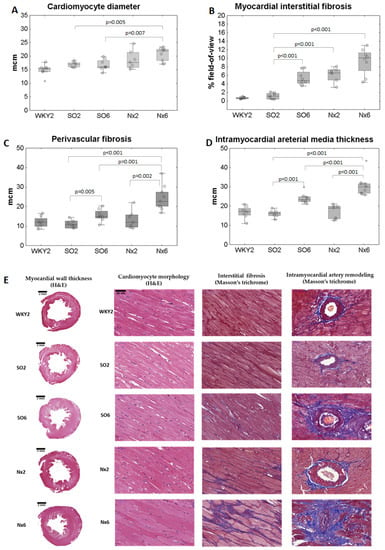
Figure 1
Open AccessPerspective
Non-Ischemic Myocardial Fibrosis in End-Stage Kidney Disease Patients: A New Perspective
by
Kenji Nakata and Nobuhiko Joki
Kidney Dial. 2023, 3(3), 311-321; https://doi.org/10.3390/kidneydial3030027 - 06 Sep 2023
Abstract
Cardiovascular medicine, especially for ischemic heart disease, has evolved and advanced over the past two decades, leading to substantially improved outcomes for patients, even those with chronic kidney disease. However, the prognosis for patients with end-stage kidney disease (ESKD) has not improved so
[...] Read more.
Cardiovascular medicine, especially for ischemic heart disease, has evolved and advanced over the past two decades, leading to substantially improved outcomes for patients, even those with chronic kidney disease. However, the prognosis for patients with end-stage kidney disease (ESKD) has not improved so greatly. Recent studies have reported that myocardial fibrosis in chronic kidney disease patients is characterized by patchy and interstitial patterns. Areas of fibrosis have been located in the perivascular space, and severe fibrotic lesions appear to spread into myocardial fiber bundles in the form of pericellular fibrosis. These findings are fully consistent with known characteristics of reactive fibrosis. In hemodialysis patients, a greater extent of myocardial fibrosis is closely associated with a poorer prognosis. In this review, we focus on non-ischemic cardiomyopathy, especially reactive myocardial fibrosis, in ESKD patients.
Full article
(This article belongs to the Special Issue Seeking out SDGs in Dialysis Medicine—Selected Articles from the JSDT Conference, Yokohama 2022)
►▼
Show Figures
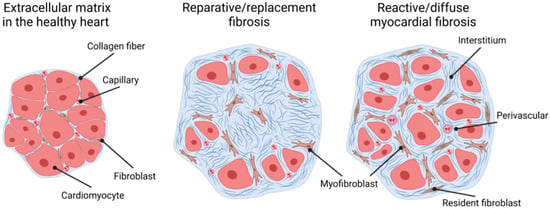
Figure 1
Open AccessArticle
Virtual Reality Mindfulness and Personalized Exercise for Patients on Hemodialysis with Depressive Symptoms: A Feasibility Study
by
Brett T. Burrows, Ashley M. Morgan, Alexis C. King, Rosalba Hernandez and Kenneth R. Wilund
Kidney Dial. 2023, 3(3), 297-310; https://doi.org/10.3390/kidneydial3030026 - 01 Sep 2023
Abstract
►▼
Show Figures
Nonadherence to exercise-related trials in hemodialysis (HD) patients is a significant burden worldwide. To address this issue, we assessed the feasibility and preliminary efficacy of a combined pre-habilitative virtual-reality-based mindfulness (VRM) program and a personalized activity prescription (PARx) in HD patients with elevated
[...] Read more.
Nonadherence to exercise-related trials in hemodialysis (HD) patients is a significant burden worldwide. To address this issue, we assessed the feasibility and preliminary efficacy of a combined pre-habilitative virtual-reality-based mindfulness (VRM) program and a personalized activity prescription (PARx) in HD patients with elevated depressive symptoms. Ten HD patients (age = 59.60 ± 13.66) with elevated depressive symptoms completed a 10-week intervention. Participants were randomized into either a VRM+PARx (n = 6) or PARx alone (n = 4) group. During the 2-week prehabilitation, the VRM+PARx group completed our VRM program, while the PARx alone group received usual HD care. Post-prehabilitation, both groups began our 8-week PARx program. Feasibility was assessed by rates of recruitment, retention, adherence, and acceptability and adoption. Preliminary efficacy was measured using metrics of depressive symptoms, mindfulness, fatigue, and physical activity (PA) energy expenditure. A 25% recruitment rate was documented, with 90% retention. A 75% exercise adherence rate was observed and PARx demonstrated high perceived autonomy support (M = 27.6 ± 2.1). Post-prehabilitation, the VRM+PARx group showed significant between-group improvement in mindfulness (p = 0.02) and a significant within-group reduction in depressive symptoms (p = 0.05); however, no difference between groups was observed (p = 0.07). Post-PARx, no between-group difference was evident in PA energy expenditure; however, within the VRM+PARx group, a significant increase in PA energy expenditure was observed (p < 0.01). Fatigue remained unchanged. Our VRM and PARx programs demonstrated feasibility and potential efficacy for HD patients. However, to validate these findings, future trials should consider a larger sample size and a longer duration.
Full article
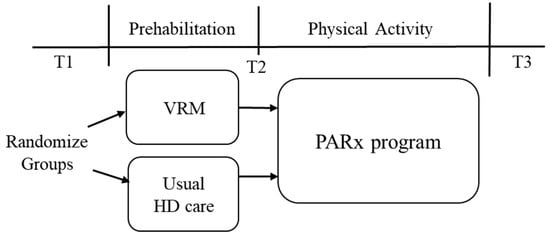
Figure 1
Open AccessReview
Trace Elements and Their Management in Dialysis Patients—Pathophysiology and Clinical Manifestations
by
Shu Wakino
Kidney Dial. 2023, 3(3), 274-296; https://doi.org/10.3390/kidneydial3030025 - 21 Aug 2023
Cited by 1
Abstract
Recently, as the number of elderly dialysis patients has been increasing, complications associated with low nutritional status such as infectious disease have had a strong influence on the prognosis of dialysis patients. Nutritional disorders are caused by the inadequate intake of the three
[...] Read more.
Recently, as the number of elderly dialysis patients has been increasing, complications associated with low nutritional status such as infectious disease have had a strong influence on the prognosis of dialysis patients. Nutritional disorders are caused by the inadequate intake of the three major nutrients—proteins, fats, and carbohydrates—as well as vitamin and mineral deficiencies. Minerals are composed of various elements, including small-amount elements and trace elements, which are present in the human body in very small quantities lower than that of iron. In dialysis and predialysis patients, zinc, manganese, and selenium are the three major elements that are significantly depleted as compared to normal subjects; these deficiencies are sometimes symptomatic. Zinc deficiency is manifest as anemia, taste abnormality, and delayed wound healing, while selenium deficiency is associated with impaired cardiac function and immunocompromised condition. Zinc has multiple functions, since various enzymes, including DNA polymerase and RNA polymerase, need zinc as a cofactor, while selenium is a component of selenoproteins, including glutathione peroxidase and thioredoxin reductases, which are major antioxidative stress enzymes. These elements can only be supplemented exogenously and contribute to the sustainable QOL of dialysis patients. On the other hand, as regards other trace elements, including copper, chromium, manganese, lead, arsenic, etc., the association of their deficiency or intoxication with various involvements of dialysis patients were investigated, although all investigations were performed in cross-sectional studies or observational studies. Therefore, the supplementation of these elements is inconclusive, given the scarcity of other intervention studies. More conclusive studies are endorsed for the establishment of proper supplementation strategies.
Full article
(This article belongs to the Special Issue Seeking out SDGs in Dialysis Medicine—Selected Articles from the JSDT Conference, Yokohama 2022)
►▼
Show Figures
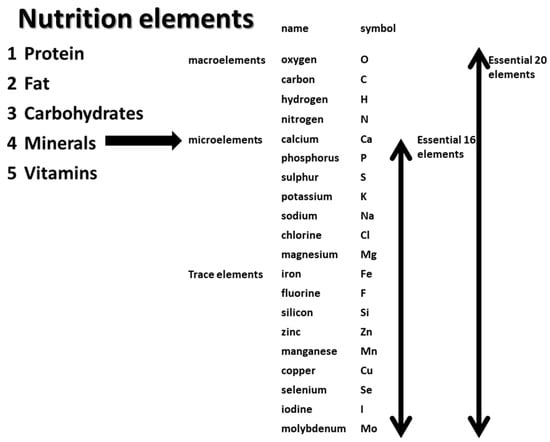
Figure 1
Open AccessArticle
The Utilization of Body Composition to Predict Cardiorespiratory Fitness and Determine Association with CKD Stage in Individuals with Mid-Spectrum CKD: A Pilot Study
by
Jeffrey S. Forsse, Kathleen A. Richardson, Tomas J. Chapman-Lopez, Ricardo Torres, Jeffery L. Heileson, Ahmed Ismaeel, LesLee Funderburk, Andrew R. Gallucci, Dale C. Allison and Panagiotis Koutakis
Kidney Dial. 2023, 3(3), 265-273; https://doi.org/10.3390/kidneydial3030024 - 03 Aug 2023
Cited by 1
Abstract
Body composition (BC), a measure of body fat mass (FM), lean body mass (LBM), and bone mineral content (BMC), can be used as a predictor of cardiorespiratory fitness (CRF). Prior studies have established a relationship between BC and VO2max in healthy individuals
[...] Read more.
Body composition (BC), a measure of body fat mass (FM), lean body mass (LBM), and bone mineral content (BMC), can be used as a predictor of cardiorespiratory fitness (CRF). Prior studies have established a relationship between BC and VO2max in healthy individuals over 35 years of age. However, this relationship is poorly understood in chronic disease populations. The focus of the study was to assess the relationship between BC, cardiorespiratory fitness, and chronic kidney disease (CKD). A cross-sectional analysis was conducted among 24 (9 males and 15 females) individuals diagnosed with mid-spectrum CKD (stages G2–G3b) who completed a health screening, dual-energy X-ray absorptiometry (DEXA) scan, and underwent a VO2max exercise test. Normality tests, descriptive statistics, Pearson’s correlations, t-tests, and ANOVAs were conducted in SAS v.9.4. The average percent body fat (%BF) was 36.28 ± 8.47%, LBM was 109.4 ± 29.1 lb, BMC was 2308.7 ± 735.1 g, and VO2max was 20.13 ± 5.04 mL/kg/min−1. BC was able to predict CRF via VO2max (R2 = 0.721, p < 0.001) and CKD stage (R2 = 0.390, p < 0.017). Positive correlations were observed in LBM (r = 0.750, p < 0.0018) and BMC (r = 0.647, p < 0.001), and negative correlations were observed with FM (r = −0.384, p < 0.032) and %BF (r = −0.802, p < 0.0001). BC was able to predict both CRF and CKD stages, with significant associations observed between BC, VO2max, and CKD stage. The progression of the CKD stage was associated with lower LBM, BMC, and VO2max values, indicating a graded effect of BC on CRF and CKD stage.
Full article
(This article belongs to the Special Issue Feature Papers for Kidney and Dialysis: Advances in Nephrology and Dialysis)
►▼
Show Figures
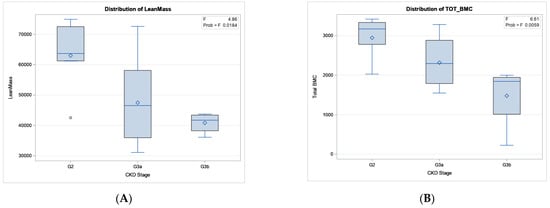
Figure 1
Open AccessCase Report
PAX 2 Mutation in an Indian Family with Renal Coloboma Syndrome
by
Kumar Digvijay, Grazia Maria Virzi, Diego Pomarè Montin, Lucas Gobetti da Luz, Maryam Momeni Taramsari, Ashwani Gupta, Manish Malik, Anurag Gupta, Vinant Bhargava, Meenakshi Verma, Claudio Ronco, Devinder Singh Rana and Anil Kumar Bhalla
Kidney Dial. 2023, 3(3), 255-264; https://doi.org/10.3390/kidneydial3030023 - 04 Jul 2023
Abstract
The transcription factor encoded by the PAX2 gene plays a significant role in the development of the urogenital tract, eyes, ears, and central nervous system. Heterozygous mutations in the PAX2 gene cause renal coloboma syndrome, a rare autosomal dominant disorder characterized by optic
[...] Read more.
The transcription factor encoded by the PAX2 gene plays a significant role in the development of the urogenital tract, eyes, ears, and central nervous system. Heterozygous mutations in the PAX2 gene cause renal coloboma syndrome, a rare autosomal dominant disorder characterized by optic nerve coloboma and renal anomalies. In this study, two siblings with chronic kidney disease (CKD) receiving regular dialysis therapy were investigated. DNA sequencing was performed on blood samples from both patients, which revealed four novel heterozygous variations in the PAX2 gene in both patients. Sequencing analysis showed a C to G transversion at position c.352 of the PAX2 gene in a heterozygous state.
Full article
(This article belongs to the Collection Teaching Cases in Nephrology, Dialysis and Transplantation)
►▼
Show Figures
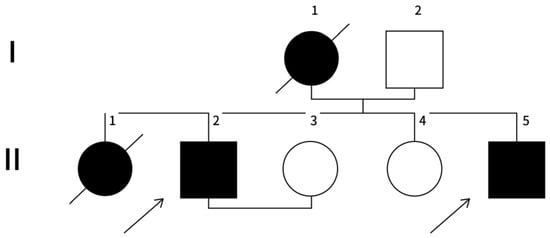
Figure 1
Open AccessArticle
The Impact of Potassium Binders on Mortality in Patients with Hyperkalemia: A Single-Center Study
by
Hajime Nagasu, Atsuyuki Tokuyama, Eiichiro Kanda, Seiji Itano, Seiji Kishi, Tamaki Sasaki and Naoki Kashihara
Kidney Dial. 2023, 3(3), 244-254; https://doi.org/10.3390/kidneydial3030022 - 28 Jun 2023
Abstract
►▼
Show Figures
Hyperkalemia is associated with an increased risk of mortality and is a common complication in patients with chronic kidney disease (CKD). Despite the prevalence of hyperkalemia, current real-world data suggest that serum potassium levels are not effectively managed in clinical practice. The potential
[...] Read more.
Hyperkalemia is associated with an increased risk of mortality and is a common complication in patients with chronic kidney disease (CKD). Despite the prevalence of hyperkalemia, current real-world data suggest that serum potassium levels are not effectively managed in clinical practice. The potential benefit of potassium binders in reducing the risk of death has not been thoroughly investigated. Therefore, this retrospective cohort study aimed to investigate the potential impact of potassium binders on mortality risk in patients with CKD by analyzing electronic medical records. The study included 1689 patients with CKD and hyperkalemia (serum potassium level > 5.0 mEq/L), who visited Kawasaki Medical School Hospital between January 2014 and December 2018. The patients were divided into two groups: those without CPS (calcium polystyrene sulphonate) treatment (CPS_OFF) and those with CPS treatment (CPS_ON). The results showed that the incidence of death was significantly higher in the CPS_OFF group than in the CPS_ON group (22.3% vs. 19.6%, p < 0.001). After propensity score matching, the CPS_ON group had a higher survival rate than the CPS_OFF group (log-rank test, p = 0.020). These results suggest that potassium binders may reduce the risk of death in patients with CKD and hyperkalemia. We hope that the results of this cohort study will be confirmed in future RCTs.
Full article

Figure 1
Open AccessPerspective
Chronic Tubulointerstitial Nephropathy of Agricultural Communities
by
Sourabh Sharma, Neha Sharma, Urmila Anandh and Swarnalata Gowrishankar
Kidney Dial. 2023, 3(2), 229-243; https://doi.org/10.3390/kidneydial3020021 - 02 Jun 2023
Abstract
►▼
Show Figures
Chronic interstitial nephritis in agricultural communities is an emerging public health concern affecting numerous agricultural communities in tropical countries, including regions in India, with a significant impact on the health and well-being of affected individuals. The affected individuals suffer from various psychosocial, nutritional,
[...] Read more.
Chronic interstitial nephritis in agricultural communities is an emerging public health concern affecting numerous agricultural communities in tropical countries, including regions in India, with a significant impact on the health and well-being of affected individuals. The affected individuals suffer from various psychosocial, nutritional, and metabolic challenges due to organ failure, which affects their quality of life. The etiology remains poorly understood, and various risk factors, which include various environmental and occupational hazards, have been implicated in its development. The recent discovery of lysosomal proximal tubulopathy has reignited interest in its pathogenesis. Along with the representative feature of chronic interstitial nephritis, changes suggestive of tubular injury have also been reported. It is suggested to use the term “chronic tubulointerstitial nephropathy of agricultural community” instead of chronic interstitial nephritis of the agricultural communities. Chronic tubulointerstitial nephropathy in agricultural communities is a slowly progressive disease that initially does not cause any symptoms in patients and most patients have a delayed onset of symptoms. Several diagnostic criteria have been introduced over the past years and one introduced by the Ministry of Health of Sri Lanka is widely used. The management of this chronic illness is no different from other causes of chronic interstitial nephritis and our focus should be on implementing various preventive strategies to reduce its incidence in agricultural communities and protect the health and well-being of agricultural workers. By disseminating knowledge about chronic tubulointerstitial nephropathy in agricultural communities, we can contribute to the development of evidence-based interventions to reduce the burden of the disease on affected communities. Moreover, we would like to sensitize physicians to this entity to increase awareness and identify potential endemic areas in various agricultural communities.
Full article
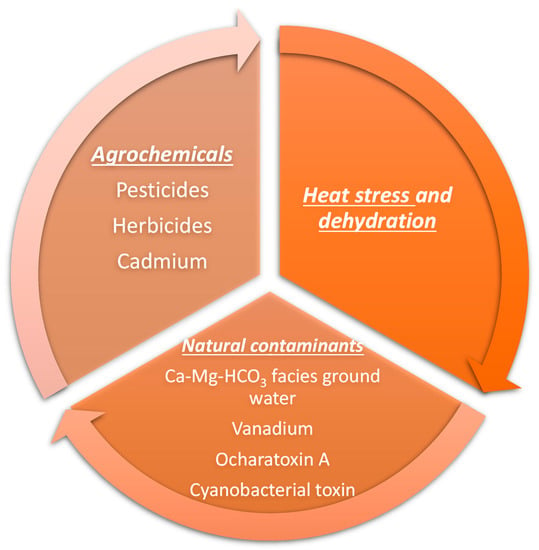
Figure 1
Open AccessPerspective
Making the Case for Standardized Outcome Measures in Exercise and Physical Activity Research in Chronic Kidney Disease
by
Thomas J. Wilkinson, Jennifer M. MacRae, Stephanie Thompson and Clara Bohm
Kidney Dial. 2023, 3(2), 219-228; https://doi.org/10.3390/kidneydial3020020 - 10 May 2023
Cited by 2
Abstract
►▼
Show Figures
Physical activity and exercise are core components of lifestyle modification strategies for the management of chronic kidney disease (CKD). Yet, physical activity levels have consistently remained poor across all stages of CKD. Exercise interventions, including aerobic and resistance training, and lifestyle interventions promoting
[...] Read more.
Physical activity and exercise are core components of lifestyle modification strategies for the management of chronic kidney disease (CKD). Yet, physical activity levels have consistently remained poor across all stages of CKD. Exercise interventions, including aerobic and resistance training, and lifestyle interventions promoting physical activity, have been shown to improve a multitude of clinical endpoints and factors important to patients; however, despite the evidence, the provision of physical activity in clinical practice is still inadequate. The usefulness of any study hinges on the adequacy and clinical relevance of the outcomes and outcome measures used. Inconsistent reporting and wide disparities in outcome use across studies limit evidence synthesis to help guide clinical practice. The kidney exercise and physical activity field has been particularly prone to inconsistent outcome reporting. To ensure research is relevant and able to influence clinical practice and future research, we need to ensure the use (and reporting) of standardized, relevant outcome measures. Core outcome sets (COS) have been widely developed across many chronic conditions, yet these COS have not been tailored to physical activity and exercise in CKD. Outcomes in clinical research need to be relevant to the intervention being employed. From this perspective, we summarize the importance that standardizing outcomes and outcome measures may have in relation to physical activity and exercise interventions for people living with kidney disease.
Full article
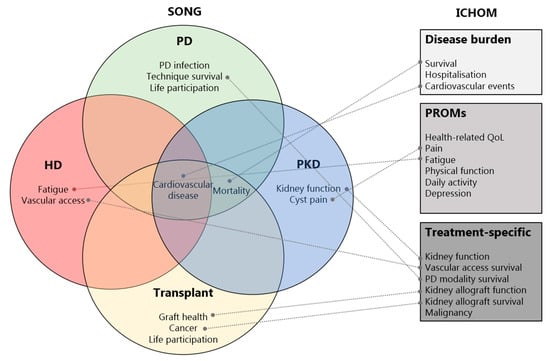
Figure 1
Open AccessArticle
Screening Differential Expression Profiles of Urinary microRNAs in a Gentamycin-Induced Acute Kidney Injury Canine Model
by
Bo Sun, Liang Chen, Zhe Qu, Yan-Wei Yang, Yu-Fa Miao, Rui-Li Wang, Xiao-Bing Zhou and Bo Li
Kidney Dial. 2023, 3(2), 204-218; https://doi.org/10.3390/kidneydial3020019 - 26 Apr 2023
Abstract
►▼
Show Figures
microRNAs (miRNAs) are promising biomarkers for different pathological models because of their stable and detectable characters in biofluids. Here, we collected urine samples from 5 beagle dogs on the 3th, 6th, and 12th day in an acute kidney injury (AKI) caused by gentamycin.
[...] Read more.
microRNAs (miRNAs) are promising biomarkers for different pathological models because of their stable and detectable characters in biofluids. Here, we collected urine samples from 5 beagle dogs on the 3th, 6th, and 12th day in an acute kidney injury (AKI) caused by gentamycin. miRNA levels were measured with high-throughput sequencing and the results were then differentially investigated. Gene Ontology (GO) and KEGG pathway analysis were performed to analyze potential target genes corresponding to the differentially expressed miRNAs (DE-miRNAs). Relationships between hub genes and DE-miRNAs were analyzed with STRING and Cytoscape. We identified 234 DE-miRNAs 3, 6, and 12 days after gentamycin treatment (p < 0.05). Top 10 up- and down-regulated candidate target genes of DE-miRNAs were predicted by overlapping TargetScan and miRanda results). GO and KEGG analyses for DE-miRNAs demonstrated that the DE-miRNAs target genes are mainly involved in kidney injury-related pathways, such as the insulin signaling pathway, oxytocin signaling pathway, and hedgehog signaling pathway. The network of miRNA-hub genes suggests that miR-452, miR-106a, and 106b participate in regulating the largest number of hub genes. We evaluated the miRNA signature via a canine model built by gentamycin-caused acute kidney injury. Our results represent a valuable resource for evaluating miRNAs as biomarkers of renal toxicity.
Full article
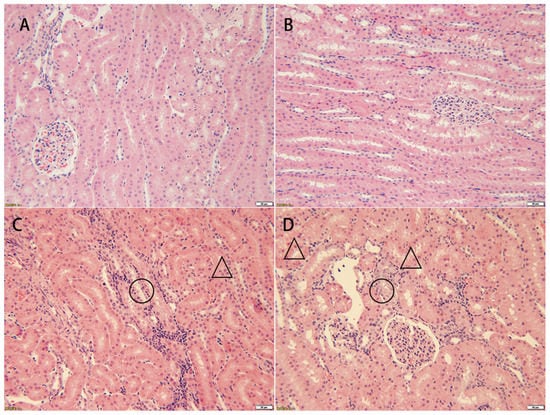
Figure 1
Open AccessCase Report
Genetic Variability of HUPRA Syndrome—A Case Report
by
Edita Petrosyan, Maria Molchanova, Berta Kushnir, Patritsia Povilaitite, Polina Tsygankova, Ekaterina Zakharova and Maria Proskura
Kidney Dial. 2023, 3(2), 196-203; https://doi.org/10.3390/kidneydial3020018 - 26 Apr 2023
Abstract
HUPRA syndrome is a rare autosomal recessive mitochondrial disorder caused by a mutation in the SARS2 gene encoding mitochondrial seryl-tRNA synthetase (mtSerRS). It includes hyperuricemia, pulmonary hypertension, renal failure, and alkalosis. We present a case report of a boy aged 1 year 2
[...] Read more.
HUPRA syndrome is a rare autosomal recessive mitochondrial disorder caused by a mutation in the SARS2 gene encoding mitochondrial seryl-tRNA synthetase (mtSerRS). It includes hyperuricemia, pulmonary hypertension, renal failure, and alkalosis. We present a case report of a boy aged 1 year 2 months with premature anemia, hyperuricemia, pulmonary hypertension, renal failure, and alkalosis and diagnosed with HUPRA syndrome. This disease is known to be progressive and fatal. A genetic test revealed a new previously undescribed heterozygous nucleotide variant in exons 14 and 1 of the SARS2 gene. The nucleotide substitution c.1295G > A (p.Arg432His) was detected in exon 14; according to the criteria of the American College of Medical Genetics (ACMG), this missense mutation is probably pathogenic. The nucleotide substitution c.227T > C (p.Leu76Pro) was detected in exon 1; according to the ACMG criteria, this missense mutation is a variant of unclear significance. We suggest that previously undescribed nucleotide substitutions in the SARS2 gene revealed in a patient with typical clinical presentation of the HUPRA syndrome should be considered as a pathogenic mutation.
Full article
(This article belongs to the Collection Teaching Cases in Nephrology, Dialysis and Transplantation)
►▼
Show Figures
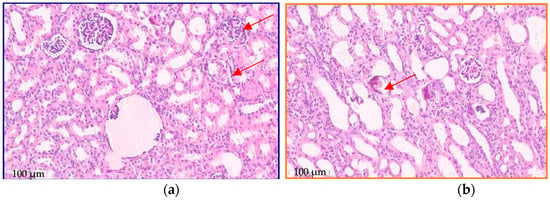
Figure 1
Highly Accessed Articles
Latest Books
E-Mail Alert
News
Topics

Conferences
Special Issues
Special Issue in
Kidney and Dialysis
Kidney Dialysis: Challenges and Opportunities
Guest Editors: Ellen K. Hoogeveen, Casper F. M. FranssenDeadline: 1 July 2024
Special Issue in
Kidney and Dialysis
Hypoxia Inducible Factors Proly-Hydroxylase Inhibitors: A Novel Treatment of CKD Patient Anemia
Guest Editors: Francesco Locatelli, Lucia Del Vecchio, Ciro EspositoDeadline: 31 December 2024
Topical Collections
Topical Collection in
Kidney and Dialysis
Teaching Cases in Nephrology, Dialysis and Transplantation
Collection Editors: Giorgina Barbara Piccoli, Elena Zakharova
